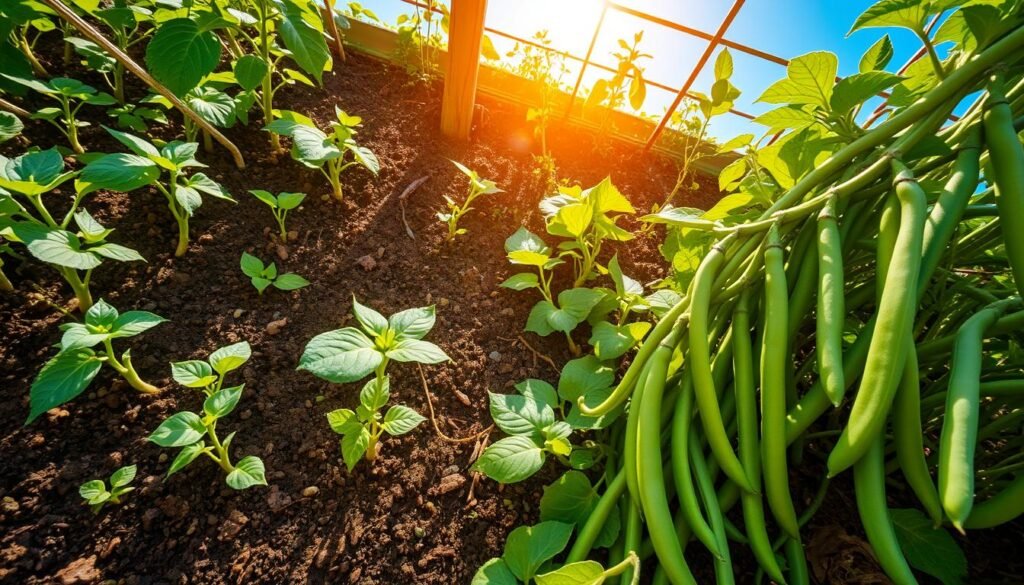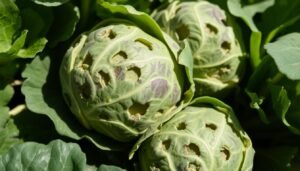Green beans, also known as Phaseolus vulgaris, start from seeds. These seeds need warm conditions to germinate. After planting, it takes 7-14 days for seedlings to appear. Then, the plants grow fast, develop leaves, bloom, and form pods.
As I stood in my garden, the warm sun kissed my shoulders. The gentle breeze danced among the seedlings. Planting green bean seeds was a moment I’ll never forget.
In this guide, I’ll share insights on how do green beans grow so fast?. You’ll learn how to grow them, helping you garden with confidence.
Green beans are easy to grow and taste great. They’re a favorite in many gardens. Knowing how to care for them is key to a good harvest.
You’ll learn from seed selection to harvest. This guide will make gardening fun and rewarding. For more tips, visit Beegreen Garden.
Key Takeaways
- Green beans can grow anywhere from 1 to 10 feet in height, depending on the variety.
- Plant green bean seeds approximately 1 inch deep and 2 inches apart for optimal growth.
- Green beans thrive best in temperatures between 65°F and 85°F.
- Consistent moisture is crucial; ensure they receive 1 to 2 inches of water per week.
- Harvesting green beans regularly encourages continuous production of fresh flowers and pods.
Table of Contents
Introduction to Green Beans
Green beans, also called edible pod beans or string beans, are a great addition to gardens. They come in colors like green, purple, and yellow. This green beans introduction talks about why they’re good for your garden.
Green beans are full of fiber, vitamins, and minerals. They have few calories, making them a healthy food choice. They help the soil by fixing nitrogen, especially when grown with corn and squash.
These plants grow well in USDA Plant Hardiness Zones 3 to 10. They need well-draining loamy soil and lots of sunlight.
I love green beans for their taste and history. They’ve been grown in places like ancient Peru and Mexico for over 7,000 years. They came to Europe in the 15th and 16th centuries and are now loved worldwide.
Learning about green beans’ needs makes gardening better. These plants are fun to grow and give a lot of food for meals.
| Characteristic | Details |
|---|---|
| Common Names | String beans, Snap beans, Pole beans |
| Colors | Green, Purple, Yellow |
| Nutritional Benefits | Rich in fiber, vitamins B6, B2, C, K |
| Optimal Growing Conditions | Full sun, well-draining loamy soil |
| Growing Zones | USDA Zones 3 to 10 |
| Harvest Time | 50 to 80 days from planting |
Understanding Green Bean Varieties
Choosing the right green bean varieties for my garden is key. Each type has its own growth habits and harvest times. This makes them perfect for different gardens and climates.
Types of Green Beans
There are many green bean types to pick from. These include bush beans, pole beans, and half-runners. Here’s what sets them apart:
- Bush beans are small and grow up to 2 feet tall. They produce pods quickly, in about three weeks.
- Pole beans need trellises because they grow long. They start slower than bush beans but keep producing all summer.
- Half-runners mix bush and pole bean traits. They’re a good middle ground.
Bush Beans vs. Pole Beans
When deciding between bush and pole beans, here’s what to consider:
| Type | Growth Height | Production Time | Yield | Flavor |
|---|---|---|---|---|
| Bush Beans | 2 feet (60 cm) | Harvests sooner, all at once | Moderate | Tender and mild |
| Pole Beans | 8-10 feet (2.5-3 m) | Later start, continuous throughout summer | Higher | More flavorful |
For example, Kentucky Wonder and Blue Lake show these differences. Kentucky Wonder grows a lot but can get stringy. Blue Lake stays tender but yields less. My choice depends on whether I want a fast harvest or ongoing production.
Planting Green Beans
Planting green beans needs careful timing and the right spot. Waiting until after the last frost is best. Soil should be at least 65°F to 70°F for growth.
Choose a sunny area with fertile, well-drained soil. This helps green beans grow well.
Choosing the Right Time and Place
Timing is key when planting green beans. Late spring is the best time after frost has gone. Direct sowing is better since beans don’t like transplanting.
Warm soil helps seeds sprout better. Use a thermometer to check soil temperature. It should be about 70°F (21°C) for planting.
Preparing the Soil
Soil prep is crucial for a good green bean garden. Mix compost into the soil for nutrients and better drainage. Beans need little fertilizer and add nitrogen to the soil.
Plant seeds one inch deep. Space pole beans six inches apart and bush beans twelve to eighteen inches. This lets plants get enough air and sunlight.
| Bean Type | Planting Depth | Spacing | Optimal Soil Temperature |
|---|---|---|---|
| Pole Beans | 1 inch | 6 inches apart | 70°F (21°C) |
| Bush Beans | 1 inch | 12-18 inches apart | 70°F (21°C) |
Good soil prep and planting in the right conditions lead to a great harvest. Keeping track of these details helps green beans grow well. For more tips, see this guide.
How Do Green Beans Grow

To understand how green beans grow, we need to look at their growth process. These vibrant vegetables love warm temperatures and need steady moisture. When I plant seeds in the right conditions, they sprout in 7 to 14 days. This happens if the soil stays moist and the temperature is just right.
As green bean plants grow, they develop quickly. Seedlings start to grow leaves, which help them catch sunlight and make food through photosynthesis. Then, flowers appear, leading to the growth of pods. For the best taste, I harvest these pods when they’re still young. This way, they stay tender and flavorful.
Green Bean Growth Stages
Knowing the green bean growth stages is key for growing them well. It starts with planting seeds. Then, there are important steps that help the plant grow. Each step shows how to care for the plants as they grow.
From Seed to Seedling
The journey begins with a seed that has everything needed to grow. Germination starts, and the seed sprouts. It takes six to fourteen days for seedlings to come out of the soil.
This is when the seed turns into a seedling. The plant gets its first true leaves after it breaks through the soil. It’s important to space them eight to twelve inches apart. This lets each seedling get enough light and nutrients.
Mature Plant Development
After six to eight weeks, the plant becomes mature. Flowers start to show up, meaning the plant is ready to make fruit. Taking good care of the plant at this time is very important.
Once the flowers are pollinated, seed pods grow. These pods are the fruits of the plant, ready to be picked or saved for later. Knowing these stages helps grow healthier plants and leads to a big harvest.
| Growth Stage | Duration | Description |
|---|---|---|
| Seed | 0 days | The initial stage, where the seed is planted in the soil. |
| Germination | 5-7 days | The seed absorbs water and swells, the radicle and shoot begin to emerge. |
| Seedling | 6-14 days | The shoot breaks the soil, and true leaves develop. |
| Flowering | 6-8 weeks | Flowers appear, signaling the plant’s reproductive stage. |
| Fruit | 8 weeks and beyond | Seed pods develop post-flowering, ready for harvest. |
Green Bean Plant Care

Proper care is key for a good harvest of green beans. Right watering and fertilizing help them grow well. Keeping the right conditions leads to a healthy garden.
Watering Requirements
For green beans, I water them with 1-2 inches of water weekly. This keeps the soil moist but not too wet. Watering well, especially when they’re flowering, helps them grow pods.
Beans like soil that drains well. So, I watch how much water they get, especially when it’s hot.
Fertilization and Nutrition
Fertilizing green beans right is important. I use a low-nitrogen fertilizer once a month. Beans can make their own nitrogen, so they don’t need too much.
I put the fertilizer 2 inches away from the plant to avoid burning the roots. This careful feeding boosts bean growth and quality.
| Aspect | Details |
|---|---|
| Watering Frequency | 1-2 inches per week |
| Soil Preference | Well-draining, consistently moist |
| Fertilizer Type | Low-nitrogen, applied monthly |
| Fertilizer Placement | At least 2 inches from plant base |
| Sunlight Requirement | At least 6 hours, preferably 8+ |
Green Bean Germination Process
Learning about green bean germination is key for growing them well. Temperature is very important for growth. The best temperature for germination is between 70°F and 80°F.
I plant my green bean seeds in these conditions. I make sure the soil stays moist. Too little water can harm the seeds and plants.
Optimal Temperature and Conditions
I plant the seeds 1 inch deep and 2 inches apart. The rows are 18 to 36 inches apart. It takes about 8 to 10 days for the seeds to sprout.
Keeping the soil moist is crucial. I aim for about 1 inch of water per week. This helps my plants stay healthy and fight off diseases.
To keep the growing area healthy, I rotate crops every three years. This helps avoid diseases and pests. I also remove pests like Mexican bean beetles by hand.
If aphids appear, a strong water spray can get rid of them. I avoid using too much manure to prevent seedcorn maggots and spider mites.
By creating the right conditions, I see my seeds grow into strong plants. For more tips, I look at detailed guides. This guide offers great advice for gardening.
Growing Green Beans from Seed
Choosing the right seeds is key when growing green beans from seed. I pick healthy, disease-resistant seeds that are virus-free. ‘Contender’ is a favorite for its quick growth, ready in about 40 days.
I also love gourmet options like ‘Maxibel’ and ‘Amethyst’. They add flavor and beauty to my garden.
Seed Selection and Preparation
Preparing seeds for planting is more than just picking the right type. I soak seeds overnight to help them sprout better. Beans need warm soil to grow well, so I wait until late spring.
This ensures the seeds grow in the best temperature range. It’s important for the first shoots to emerge.
Direct Sowing Techniques
Direct sowing involves planting seeds at a depth of one inch. I space them right for bush or pole beans. Bush beans are planted closer together to use space well.
Pole beans need more space to grow tall. I sow seeds every few weeks for a steady harvest. This way, I get plenty of fresh beans in the warmer months.




